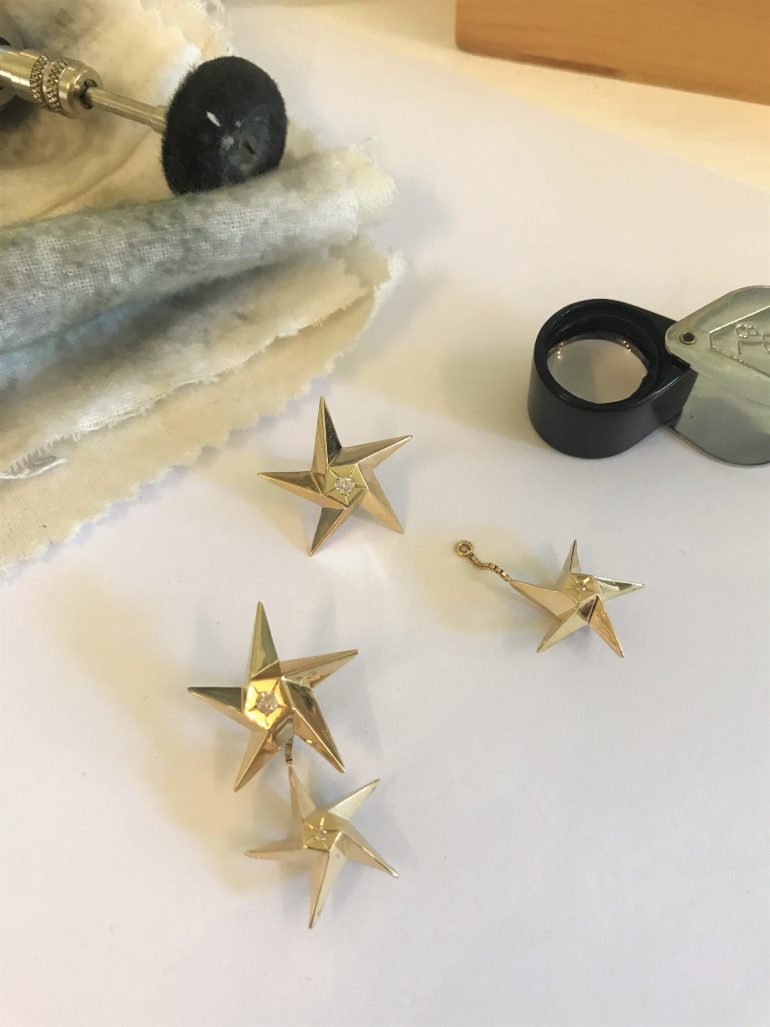Wearing and Storing Jewels
Fine jewellery is made to last but all jewellery benefits from being handled and worn with care, and being kept clean.
When putting on your jewellery check that fastenings are secure on necklaces and bracelets and that butterflies are tight on earrings, especially when changing clothing. Apply hair products and toiletries before putting on your jewellery. Take care not to knock your rings or bangles on hard surfaces such as door handles or glass tables, as the metal may dent and gemstones can crack or chip, or a setting may loosen. Even diamonds as the hardest stone are not infallible. Wearing jewellery in bed, while swimming, showering or at the gym should be avoided, and jewellery should be removed when using potentially damaging equipment.
When not wearing jewellery, keep it in a soft pouch or jewellery box and out of direct sunlight, also when carrying jewellery also protect it in a box or pouch. Avoid jewellery pieces scratching one another by storing them separately.
Cleaning Fine Jewellery and Gemstones
Almost all jewels can be washed using this simple process: Set up a small basin or bowl of warm water with a few drops of washing up liquid, using either a sponge or a very soft toothbrush gently brush the jewellery piece outside and inside, where it sits on the skin and behind the gemstone. Rinse and pat dry with a soft cloth or tea towel. Please always remember to close your drain if you are cleaning near a sink.
Diamonds, sapphires and rubies are strong gemstones but aquamarine, emerald, tourmaline, amethyst, citrine and other coloured gemstones should be worn with a little more care and are softer than diamonds, sapphires and rubies, they can all be cleaned using the method above. The following stones are porous however, such as pearls, opal, coral, turquoise, and these must not be immersed in strong cleaning products or left to soak. Clean pearls and porous stones using a clean soft cloth, the cloth can be slightly damp. Strung pearls should not be immersed in water at all. Pearls love to be worn as moisture from the skin enhances the lustre but always apply perfumes and creams before putting on your pearl jewellery not directly on the stones.
Precious Metals
18 carat (18ct or 18k) yellow gold consists of 75% pure gold, with the rest of the precious metal alloy made of silver and copper, varying these combinations results in slightly different colours of yellow gold and rose gold. 18ct rose gold contains 75% gold but has a little more copper and 18ct white gold is 75% gold with the rest of the alloy made of platinum or palladium. The fineness of gold is tested for each piece and marked on the Hallmark with 18ct being marked 750 for 75% as 24 carat is 100% pure gold. Platinum is marked 950, it consists of 95% fine platinum and 5% other alloys.
18ct yellow and rose gold need little polishing as they do not tarnish easily and are stronger than 24 carat gold, although care should always be taken they need little maintenance. While lasting and durable, gold can become scratched or dented, particularly if handled roughly. Regularly check your gold jewellery for loose prongs or any damage. Some fine gold chain is very delicate, so please take care not to tug or catch the chain and check catches are securely fastened.
18ct white gold and platinum rings may need re-polishing depending on the level of wear and tear. 18ct white gold is plated in rhodium (in the platinum family, a hard, durable, silvery-white metal) which can be polished to a high shine, on earrings and necklaces the rhodium can last a lifetime but on rings the rhodium will start wearing off where there is a lot of friction. White gold pieces can be easily repolished and replated with the rhodium layer and be brightened and refreshed.

